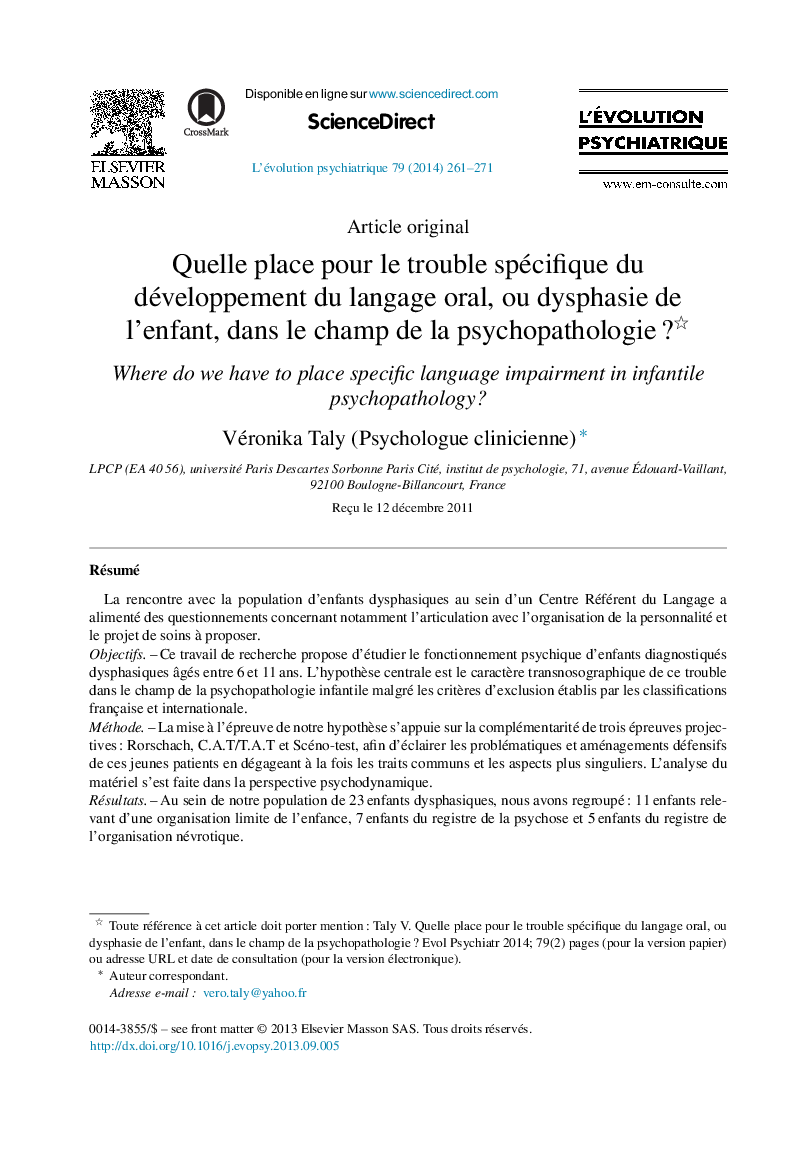| کد مقاله | کد نشریه | سال انتشار | مقاله انگلیسی | نسخه تمام متن |
|---|---|---|---|---|
| 908575 | 917185 | 2014 | 11 صفحه PDF | دانلود رایگان |

RésuméLa rencontre avec la population d’enfants dysphasiques au sein d’un Centre Référent du Langage a alimenté des questionnements concernant notamment l’articulation avec l’organisation de la personnalité et le projet de soins à proposer.ObjectifsCe travail de recherche propose d’étudier le fonctionnement psychique d’enfants diagnostiqués dysphasiques âgés entre 6 et 11 ans. L’hypothèse centrale est le caractère transnosographique de ce trouble dans le champ de la psychopathologie infantile malgré les critères d’exclusion établis par les classifications française et internationale.MéthodeLa mise à l’épreuve de notre hypothèse s’appuie sur la complémentarité de trois épreuves projectives : Rorschach, C.A.T/T.A.T et Scéno-test, afin d’éclairer les problématiques et aménagements défensifs de ces jeunes patients en dégageant à la fois les traits communs et les aspects plus singuliers. L’analyse du matériel s’est faite dans la perspective psychodynamique.RésultatsAu sein de notre population de 23 enfants dysphasiques, nous avons regroupé : 11 enfants relevant d’une organisation limite de l’enfance, 7 enfants du registre de la psychose et 5 enfants du registre de l’organisation névrotique.DiscussionLa diversité des registres de fonctionnement de la personnalité repérée au sein de notre échantillon tend à conforter notre hypothèse sur le caractère transnosographique de la dysphasie dans le champ de la psychopathologie infantile.ConclusionLa clinique projective se révèle précieuse aussi pour ces enfants dysphasiques puisque de ce fait leur prise en charge thérapeutique ne se limite pas à la fonction instrumentale et qu’un soin psychique peut être proposé pour nombre d’entre eux.
The encounter with a population of dysphasic children in a Language Impairment Centre has raised questions notably regarding the articulation with the organisation of each personality and the project of care to be proposed.ObjectivesThis research work proposed to study the mental functioning of children aged 6 to 11 and diagnosed with dysphasia. The central hypothesis was the transnosographic nature of this disorder in the scope of an infantile psychopathology, despite the exclusion criteria established by the French and international classifications.MethodThe testing of our hypothesis was based on the complementary nature of three projective tests: the Rorschach, the CAT/TAT and the Sceno-test, in order to shed light on the problems and defensive adjustment of these young patients by underlining the mutual characteristics and the most uncommon aspects. Analysis of the material was conducted in a psychodynamic perspective.ResultsWithin our population of 23 dysphasic children, we regrouped: 11 having developed borderline personality traits in childhood, 7 children with psychosis and 5 children presenting neurotic personality traits.DiscussionThe diversity of the functioning personality registers discovered in our sample tends to confirm our hypothesis of the transnosographical nature of dysphasia within the infantile psychopathological field.ConclusionThe projecting clinical picture is precious for these dysphasic children, since their therapeutic management is not only limited to the instrumental function, and mental care can be proposed to many of them.
Journal: L'Évolution Psychiatrique - Volume 79, Issue 2, April–June 2014, Pages 261–271